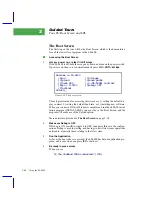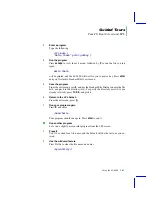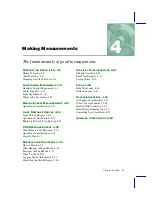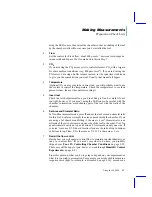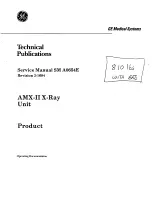
Making Measurements
Preparation Check Lists
Using the LI-6400
4-7
using the LED source, then orient the chamber so that no shading of the leaf
by the chamber walls will occur once youÕve installed the leaf.
2
Flow
Set the control for Fixed flow, about 400 µmol s
-1
, desiccant mid-range be-
tween scrub and bypass. WeÕll come back to this in Step 7.
3
CO
2
If you are using the CO
2
mixer, set it to control reference CO
2
with a target a
bit above ambient conditions (say, 400 µmol mol
-1
). If you arenÕt using the
CO
2
mixer, but using a buffer volume instead, set the soda lime scrub knob
to give you the concentration you want. Usually, that means full bypass.
4
Temperature
(Optional) If you are going to be in direct sun, you will probably want to use
the coolers to control the temperature. Check the temperatures to see their
present values, then set the control accordingly.
5
Insert leaf
Check the latch adjustment for a good seal. Snug is fine; be careful itÕs not
too tight, however. If you arenÕt using the LED source, be careful with the
chamberÕs orientation; avoid shading part of the leaf with the walls of the
chamber.
6
Set Area and Stomatal Ratio
In New Measurements mode, press
3
, and set the leaf area and stomatal ratio
for this leaf. Leaf area is simply the area exposed inside the chamber. If you
are using a 2x3 chamber and filling it, the area is 6 cm
2
. Stomatal ratio is an
estimate of the ratio of stomata on one side of the leaf to the other. Use 1 for
equal stomatal density on top and bottom; 0 for stomata on only one side. If
you arenÕt sure, use 0.5. It doesnÕt matter if you use the ratio of top to bottom,
or bottom to top. Thus, 0.5 is the same as 2; 0.333 is the same as 3, etc.
7
Revisit the flow control
Decide how you will operate: control flow to maintain constant humidity, or
run at a constant flow. (If you arenÕt sure what to do here, you probably
skipped over
Tour #3: Controlling Chamber Conditions
There may still be hope for you, however; work through
From this point on, what you do is going to depend on your experiment, or
what it is you wish to accomplish. For example, you might wish to measure a
response curve (light, for example, is discussed on page 4-24), or make sur-
Summary of Contents for LI-6400
Page 1: ...Using the LI 6400 Portable Photosynthesis System ...
Page 15: ...Part I The Basics ...
Page 16: ......
Page 174: ...Making Measurements Answers to Questions 4 56 Using the LI 6400 4 ...
Page 175: ...Part II Useful Details ...
Page 176: ......
Page 200: ...Standard Tools Power ON Hooks 5 24 Using the LI 6400 5 ...
Page 214: ...Real Time Data Real Time Graphics 6 14 Using the LI 6400 6 ...
Page 234: ...Environmental Control Light Control 7 20 Using the LI 6400 7 ...
Page 244: ...Light Sensor Considerations Gallium Arsenide Phosphide GaAsP Sensor 8 10 Using the LI 6400 8 ...
Page 288: ...Data Logging Making Your Own AutoPrograms 9 44 Using the LI 6400 9 ...
Page 289: ...Part III Working With Files ...
Page 290: ......
Page 312: ...The LPL File System Troubleshooting 10 22 Using the LI 6400 10 ...
Page 340: ...Downloading Files Using a Data Capture Program 11 28 Using the LI 6400 11 ...
Page 375: ...Part IV Configuration Issues ...
Page 376: ......
Page 420: ...Defining User Variables Old Style vs New Style 15 18 Using the LI 6400 15 ...
Page 454: ...Using an Energy Balance Further Reading 17 12 Using the LI 6400 17 ...
Page 455: ...Part V Maintenance Troubleshooting ...
Page 456: ......
Page 572: ...Troubleshooting Useful Information 20 46 Using the LI 6400 20 ...
Page 593: ...Part VI Programming ...
Page 594: ......
Page 622: ...Programming with LPL Compiler Directives 22 28 Using the LI 6400 22 ...
Page 846: ...Index I 16 Using the LI 6400 ...


